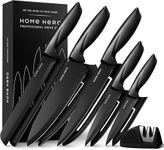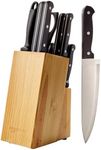Buying Guide for the Best Budget Knife Set
Choosing the right knife set is crucial for any kitchen, whether you're a professional chef or a home cook. A good knife set can make food preparation easier, safer, and more enjoyable. When selecting a knife set, consider the types of knives included, the materials used, and how they fit your cooking style and needs. It's important to find a balance between quality and the number of pieces in the set, ensuring you have the essential knives without unnecessary extras.Types of Knives IncludedA knife set typically includes a variety of knives, each designed for specific tasks. Common types include a chef's knife, paring knife, bread knife, and utility knife. The chef's knife is versatile and can handle most tasks, while a paring knife is great for peeling and intricate work. A bread knife is essential for slicing bread without crushing it, and a utility knife is a smaller, all-purpose knife. Consider what types of cooking you do most often to determine which knives are essential for you. If you frequently bake, a bread knife is a must, while a chef's knife is indispensable for most cooking tasks.
Blade MaterialThe material of the knife blade affects its sharpness, durability, and maintenance. Common materials include stainless steel, carbon steel, and ceramic. Stainless steel is resistant to rust and easy to maintain, making it a popular choice for home cooks. Carbon steel is sharper and holds an edge longer but requires more maintenance to prevent rust. Ceramic blades are very sharp and lightweight but can be brittle. Choose a material based on your willingness to maintain the knives and your preference for sharpness and durability. If you prefer low maintenance, stainless steel is a good choice.
Handle Material and ComfortThe handle material and design affect the comfort and safety of using the knife. Common handle materials include wood, plastic, and composite. Wood handles offer a traditional look and feel but may require more care. Plastic handles are durable and easy to clean, while composite handles offer a balance of comfort and durability. The shape and size of the handle should fit comfortably in your hand to prevent fatigue and ensure safe handling. Consider how the knife feels in your hand and choose a handle that provides a secure grip, especially if you cook for extended periods.
Number of PiecesKnife sets can range from a few essential pieces to large collections with many specialized knives. A smaller set with high-quality knives is often more practical than a large set with knives you rarely use. Focus on the essential knives you need for your cooking style. A basic set with a chef's knife, paring knife, and bread knife is sufficient for most home cooks. If you perform more specialized tasks, consider sets that include additional knives like a boning knife or carving knife. Evaluate your cooking habits to determine the right number of pieces for your needs.
Storage OptionsKnife sets often come with storage solutions like a knife block, magnetic strip, or sheath. Proper storage is important to protect the blades and ensure safety in the kitchen. A knife block is convenient and keeps knives organized on the countertop, but it takes up space. A magnetic strip saves counter space and allows easy access, but requires wall installation. Sheaths protect individual knives and are ideal for drawer storage. Consider your kitchen space and how you prefer to access your knives when choosing a storage option. Ensure the storage method keeps the knives secure and easily accessible.

















